NCERT Solutions Class 8 English Poorvi Chapter 2 A Concrete Example of Unit 1 Wit and Wisdom updated for Session 2025-26. Class 8 English Chapter 2 New Edition gives detailed explanations, question-answers and vocabulary support to help students understand the theme and humour of the chapter easily. These solutions are designed as per the latest syllabus and help in exam preparation and classroom revision. Ideal for self-study, the NCERT Poorvi Solutions for Session 2025–26 focus on enhancing comprehension and analytical skills in an engaging manner.
► Class 8 English Poorvi Unit 1 Chapter 2 MCQs
► Class 8 English (Old and New Book) Solutions
► Summary of the Chapter
► English to Hindi Translation
A Concrete Example Class 8 English Poorvi Chapter 2 Answers
Page 17
Let us do these activities before we read.
I Read the names of items you usually find in a garden and write their names against each picture given below.
garden hose, sapling, hedge, flower beds, flower pot, pebbles, rockery, fence, vine, wheelbarrow

Answer:
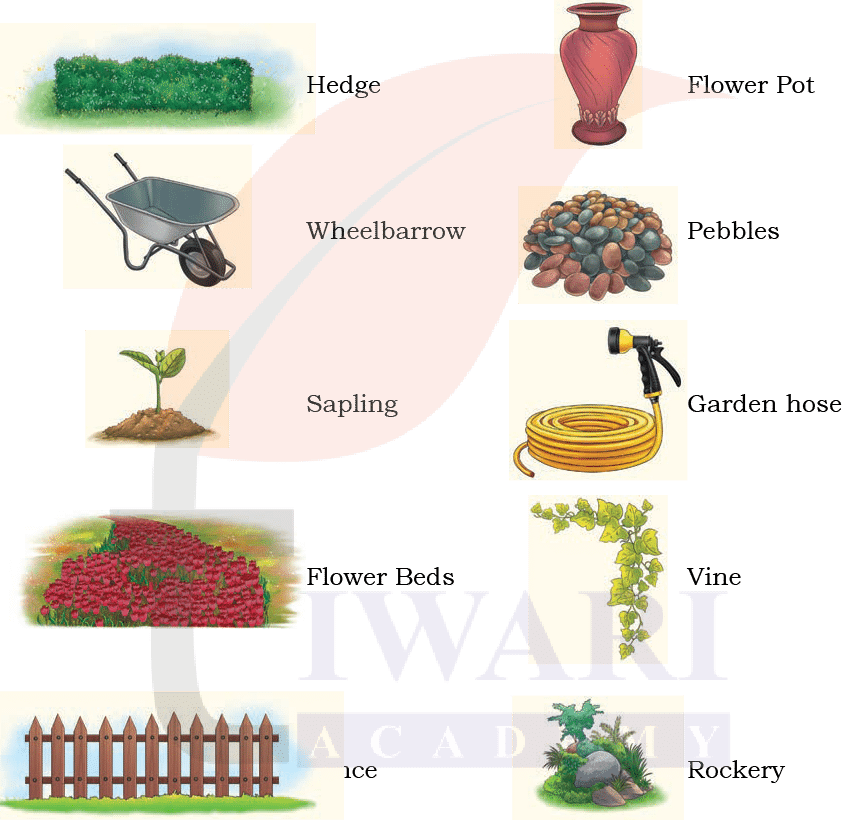
II Work in groups of four. What kind of garden would you like to have?
Mention the features that you can include and the reasons for your choice. Share your answers with your classmates and teacher.
See AnswerOur Dream Garden
We would like to have a colourful flower garden. It will have rows of roses, sunflowers, lilies and hibiscus because flowers make the garden bright and cheerful. There will also be a small vegetable patch with tomatoes, beans and carrots, so that we can eat fresh and healthy food.
In one corner, we want a fish pond with lotus leaves. It will make the garden peaceful and pretty. A few fruit trees like mango and guava will give us shade and tasty fruits. We will also keep a sitting area with benches so that friends and family can relax.
We chose these features because we want our garden to be beautiful, useful and peaceful. Flowers will give joy, vegetables will give health and trees will give shade and freshness.
III Read the title of the poem. What comes to your mind when you read the word ‘concrete’? Does it have more than one meaning ? Share your answers with your classmates and teacher.
See AnswerWhen I read the word “concrete”, first I think of cement or stones used in buildings, because we see concrete everywhere in walls and roads. But the word also has another meaning. It can mean something that is clear, real or definite.
So, the title “A Concrete Example” has two meanings. One is about the stone garden of Mrs. Jones and the other is about giving a clear example of her unusual taste.
This double meaning makes the title funny and clever.
Page 19
Let us discuss
I. Complete the following summary with exact words from the poem. One example has been done for you. Share your answers with your classmates and teacher.
The poem describes Mrs. Jones, the speaker’s next-door neighbour, who has a unique garden filled with 1._______. Her garden includes a peculiar 2.______, a pond, and a rockery, along with an unusual 3.________ that she finds charming. Mrs. Jones plants tiny, 4.________ plants between the stones, which the speaker thinks must be so small that they are planted with a 5._______. One day, Mrs. Jones invites the speaker to see her garden, and they discuss a 6.________ that Mrs. Jones treasures. When the speaker asks where the 7._______ flower is, Mrs. Jones says that the speaker has been 8.________ on it all along.
See AnswerThe poem describes Mrs. Jones, the speaker’s next-door neighbour, who has a unique garden filled with 1. stones. Her garden includes a peculiar 2. path, a pond, and a rockery, along with an unusual 3. sundial that she finds charming. Mrs. Jones plants tiny, 4. delicate plants between the stones, which the speaker thinks must be so small that they are planted with a 5. pin. One day, Mrs. Jones invites the speaker to see her garden, and they discuss a 6. flower that Mrs. Jones treasures. When the speaker asks where the 7. lovely flower is, Mrs. Jones says that the speaker has been 8. standing on it all along.
II Select the correct option to fill in the blanks for the following sentences.
1. The tone of the poem is ______.
(i) Mocking
(ii) Humorous
(iii) Mournful
(iv) Amusing
(v) light-hearted
A. (i), (ii) and (iii)
B. (i), (ii) and (v)
C. (ii), (iii) and (iv)
D. (ii), (iv) and (v)
See AnswerD. (ii), (iv) and (v)
2. The speaker in the poem is ______.
(i) Mrs. Jones
(ii) the poet
(iii) a gardener
(iv) a child
See Answer(ii) the poet
3. The rhyme scheme of the poem is ______.
(i) AABBCC
(ii) ABABCC
(iii) AABCAC
(iv) ABBACC
See Answer(ii) ABABCC
III. Complete the following sentences by choosing the correct answer given in the brackets.
1. 1. The poet uses the word ‘stones’ in all stanzas in order to emphasise her ________. (obsession with a stony garden/pride in gardening skills)
See AnswerThe poet uses the word ‘stones’ in all stanzas in order to emphasise her obsession with a stony garden.
2. The poet uses imagery to describe the features of the garden that help readers _________. (understand Mrs. Jones love for plants/visualise the gardens peculiar nature)
See AnswerThe poet uses imagery to describe the features of the garden that help readers visualise the gardens peculiar nature
IV. Pick examples of alliteration from the poem.
See AnswerAlliteration means the repetition of the same sound at the beginning of words.
Examples of alliteration from the poem A Concrete Example:
• “Garden full of stones” (repeating ‘g’ sound)
• “Delicate and small” (repeating ‘d’ sound)
• “Strange device” (repeating ‘s’ sound)
• “crazy path” (the sound c repeats)
• “planting pansies” (the sound p repeats)
• “small, frail things” (the sound s repeats)
V. A refrain is a repeated line or phrase that appears in each stanza. Identify the refrain from the poem.
See AnswerThe refrain from the poem:
“My next-door neighbour, Mrs. Jones”
VI. Irony is a literary device that emphasises the difference between what is expected and what actually happens. It often involves a situation where the outcome is the opposite of what is expected, creating a surprising or a humorous effect. For example, Mrs. Jones’ excitement about her garden contrasts with the speaker’s disappointment on how ordinary it is.
Identify the line(s) from the poem that display(s) situational irony.
See AnswerWhen the speaker asks “Where is this lovely flower?” and Mrs. Jones replies “You’re standing on it” – it’s funny because the speaker didn’t notice the flower at all.
VII. Complete the following sentences appropriately.
1. The word concrete can refer to ________ in Mrs. Jones garden.
2. The title also has a symbolic meaning, as the poem provides a clear or concrete example of Mrs. Jones’ ________ gardening habits.
See Answer1. Stones
2. Symbolically
VIII. The title ‘A Concrete Example’ carries both literal and symbolic (metaphorical) meaning. Such word play is called a pun. A pun is a figure of speech that uses words with multiple meanings or words that sound alike but have different meanings, creating a humorous effect.
• I tried arguing with my pencil but it kept making sharp points. (suggests the idea of an actual sharp pencil point and strong argument points).
• My pencil and I had a disagreement but we finally got to the point. (refers to solving an argument and the pencils tip).
See AnswerThe title “A Concrete Example” is a pun because it has two meanings:
• Literal meaning: “Concrete” means stones or cement, which matches Mrs. Jones’s stone garden.
• Symbolic meaning: “Concrete” also means something clear or definite, which is the speaker giving a clear example of Mrs. Jones’s unusual taste.
Pun examples:
(i) “The light backpack was so light, I barely felt it!”
(ii) “We moved by the river bank to deposit money in the bank”.
Class 8 English Poorvi Chapter 2 Answers Explanation
Page 20
Let us think and Reflect
I. Read the given extract and answer the questions that follow.
1. My next-door neighbour, Mrs. Jones,
has got a garden full of stones:
A crazy path, a lily pond,
a rockery and, just beyond
A sundial with a strange device,
which Mrs. Jones thinks rather nice.
(i) What can be inferred about Mrs. Jones’s taste in gardening from the description of her garden being ‘full of stones’?
See AnswerMrs. Jones has unusual gardening tastes because she fills her garden with stones instead of flowers. She prefers stone decorations like a rockery and sundial over traditional plants, showing she enjoys unique, non-living garden elements.
(ii) Identify whether the following statement is true or false.
The garden serves as a means to reveal more about Mrs. Jones herself.
See AnswerTrue.
The garden reveals Mrs. Jones’ personality – her love for unusual items (strange sundial), patience (planting tiny flowers), and sense of humor (about stepped-on flowers). Her garden reflects her creative and non-traditional character.
(iii) What does the poet mean by ‘crazy path’?
See AnswerA “crazy path” suggests a winding, uneven walkway that looks wild or randomly designed, not straight or neat. This matches her unconventional garden style where nothing is ordinary or perfectly arranged.
(iv) What does the sundial with a ‘strange device’ suggest about Mrs. Jones’ personality?
A. She has a fascination with unusual items.
B. She prefers traditional garden decorations.
C. She is uninterested in her garden’s appearance.
D. She likes modern and expensive items.
See AnswerA. The strange sundial shows she likes unusual items.
Explanation: She chooses odd decorations over normal garden ornaments, proving her fascination with peculiar objects.
II Answer the following questions.
1. How does Mrs. Jones feel about her garden? Support your answer with evidence from the poem.
See AnswerMrs. Jones loves her garden deeply. She proudly shows her stones, calls the sundial “nice” and carefully plants tiny flowers between stones. Her excitement when discussing the flower for 15 minutes proves her passion for her unique garden.
2. Why do you think the speaker describes the plants as being so small that they could be planted with a pin?
See AnswerThe speaker exaggerates the plants’ size to emphasize how unimportant they seem compared to the stones. By saying they’re planted with a pin, he highlights how tiny and barely noticeable they are in the stone-filled garden.
3. What do we get to know about Mrs. Jones based on her gardening style and her interaction with the speaker?
See AnswerMrs. Jones is patient (plants tiny flowers), creative (designs with stones) and humorous (about the stepped-on flower). Her gardening style shows she values uniqueness over traditional beauty and enjoys surprising visitors.
4. The poem portrays Mrs. Jones in a positive light. Support this statement.
See AnswerThe poem shows Mrs. Jones positively through her enthusiasm (“rather nice” sundial), dedication (planting delicate flowers) and friendly nature (inviting the speaker over). Even her humor about the flower makes her likable.
5. What does the poem tell us about the way people think differently about the world around them?
See AnswerThe poem shows people see things differently: Mrs. Jones finds beauty in stones and tiny flowers, while the speaker almost misses them. This teaches us that value depends on personal perspective.
Class 8 Poorvi Unit 1 Chapter 2 All Question Answers
Page 21
Let us learn
I. Select the appropriate word from the brackets that correctly replaces the underlined word in the sentences from the text.
1. A sundial with a strange device,
(unusual, peculiar, new, rare, external).
See Answerpeculiar
Because both words suggest something unusual or distinctive, but “peculiar” better fits Mrs. Jones’ unique sundial that she finds interesting. The other options either don’t match as well or change the meaning.
2. Which Mrs. Jones thinks rather nice.
(pleasant, superior, agreeable, gentle, charming).
See AnswerPleasant
Because it maintains the same level of positive feeling without being too strong. “Charming” would be excessive, while “agreeable” is too formal for describing the sundial.
3. They are so delicate…
(delicious, fragile, dainty, graceful, weak)
See AnswerFragile
Because both words emphasize how easily the small plants could be damaged. While “dainty” suggests attractiveness, and “weak” is too negative, “fragile” best matches the poem’s description of the tiny plants.
4. Where is this lovely thing? I cried.
(exclaimed, wept, shouted, announced, whispered)
See AnswerExclaimed
Because both words convey sudden, loud speech expressing surprise. “Shouted” would be too aggressive and “wept” would completely change the meaning to sadness instead of surprise.
II. The sundial is referred to as a device in the poem. Work in pairs to infer the meaning of device. Share your thoughts with your classmates and teacher.
See AnswerThe term “device” in the poem refers to the sundial’s special mechanism or unique design feature. It suggests Mrs. Jones’ sundial has some distinctive quality that makes it different from ordinary sundials, reflecting her preference for unusual garden items.
Now, match the type of instruments in Column 1 with their definitions in Column 2. Column 3 shows one example of each type of instrument. Add more examples in Column 3.
| Column 1 | Column 2 | Column 3 |
|---|---|---|
| 1. Implement | (i) Something that is electrical and is used to do work in the house. | Spade, knife |
| 2. Tool | (ii) Something small that is mechanical or electronic. | Hammer |
| 3. Equipment | (iii) Something that works on being moved by hand. | Cricket bat, helmet, batting gloves, etc. |
| 4. Appliance | (iv) A set of necessary items for a particular purpose. | Mixer grinder |
| 5. Gadget | (v) Something used by hand to make or repair. | Mobile phone, laptop |
Answer:
| Column 1 | Column 2 | Column 3 |
|---|---|---|
| 1. Implement | (v) Something used by hand to make or repair. | Spade, knife, Chisel, Axe, Trowel, Saw, File, etc. |
| 2. Tool | (ii) Something small that is mechanical or electronic. | Hammer, Screwdriver, Wrench or Spanner, Electric drill, Glue gun, Multimeter, Pliers, Soldering iron, etc. |
| 3. Equipment | (iv) A set of necessary items for a particular purpose. | Cricket bat, helmet, batting gloves, Raincoat, Umbrella, etc. |
| 4. Appliance | (i) Something that is electrical and is used to do work in the house. | Mixer grinder, Washing machine, Microwave oven, Refrigerator, Vacuum cleaner, Electric iron, Toaster, Water heater, Air conditioner, etc. |
| 5. Gadget | (iii) Something that works on being moved by hand. | Mobile phone, laptop, Calculator, Smartwatch, Bluetooth speaker, Digital thermometer, Remote control, USB fan, etc. |
III. Complete the table by making new words in Column 1 using the hints given in Column 2. Replace the first letter of the given word to create new words. One example has been done for you.
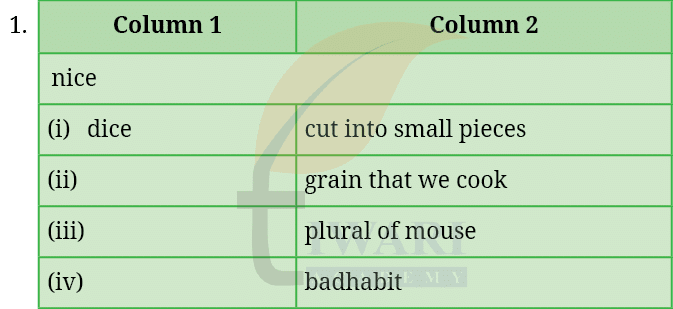
Answer:
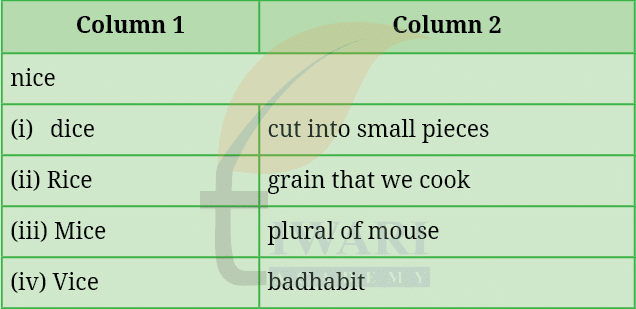
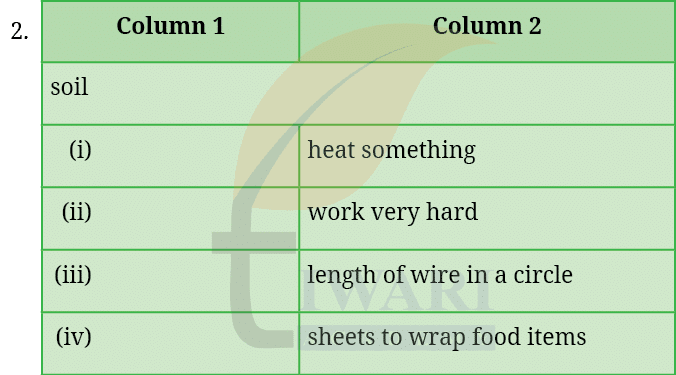
Answer:
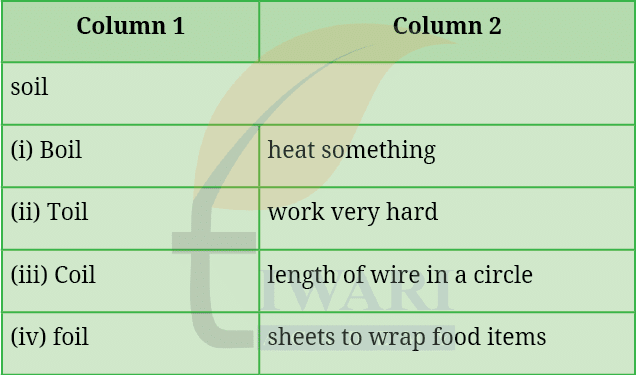
Page 23
Let us listen
I. You will listen to a presentation about the wonderful Rock Garden of Chandigarh. As you listen, answer the following questions using one to three exact words from the presentation.
1. Where was Nek Chands Rock Garden featured?
See AnswerThe Rock Garden of Chandigarh was featured in an international exhibition showcasing unique art installations. Nek Chand’s creation gained global recognition for its innovative use of recycled materials in artistic sculptures displayed outdoors.
2. What kind of sculptures does the Rock Garden have?
See AnswerThe garden contains sculptures made from industrial and home waste materials. These include figures crafted from broken ceramics, discarded glass bottles and other recycled items transformed into artistic displays through creative arrangement and cement work.
3. How is the Rock Garden divided?
See AnswerThe Rock Garden is divided into three distinct phases or sections. Each phase represents different artistic styles and contains various types of sculptures arranged in open-air galleries connected by winding pathways and water features.
4. Name any one thing that has been transformed into a piece of art in the Rock Garden.
See AnswerAmong many transformed items, broken bathroom tiles have been creatively reused as mosaic artwork. These colorful tile pieces decorate sculptures and walls throughout the garden, giving new life to what was once considered waste material.
5. Approximately, how many statues border the Rock Garden?
See AnswerApproximately 5,000 statues border the pathways and areas of the Rock Garden. These numerous sculptures create a dense artistic environment where visitors can discover new figures around every corner of the expansive outdoor exhibition space.
Let Us speak
I. The speaker of the poem might have felt sorry for stepping on Mrs. Jones flower. When we make a mistake, we must express regret and apologise for our actions.
1. When we apologise to a friend or a family member, we use informal language. Take turns to apologise for the following situations and respond to the apology.
(i) You have eaten your brothers share of sweets.
See Answer“I’m really sorry I ate your share of sweets. I shouldn’t have taken them without asking. Next time I’ll check with you first. Maybe I can buy you new ones to make up for it?
(ii) You have broken your sisters flower craft.
See Answer“Please forgive me for breaking your flower craft. I know you worked hard on it. I’ll help you make a new one and I’ll be more careful with your things in the future”.
(iii) You accidentally spilled ink on your mothers important documents.
See Answer“Sorry I didn’t mean to spill ink on mom’s important papers. I’ll help recopy the damaged pages and clean the mess. I’ll be more careful where I put my ink bottles from now on”.
(iv) You forgot to bring your friends notebook to the school after borrowing it.
See Answer“I’m sorry about forgetting your notebook. That was careless of me. I’ll bring it tomorrow for sure and you can borrow my notes today to catch up on what you missed”.
You may use the following phrases given below.
| Phrases for Apology | Phrases to Respond to Apology |
|---|---|
| (i) I’m sorry about… | (i) That’s alright. |
| (ii) I’m really sorry… | (ii) It’s no big deal. |
| (iii) Please forgive me for… | (iii) No problem. |
| (iv) Sorry, I didn’t mean to… | (iv) These things happen. |
2. When we apologise to someone in authority like a Principal or a teacher in a formal setting, we use formal language. Work in pairs and take turns to apologise for the following situations and respond to the apology.
(i) You did not bring an assignment that was due for submission.
See Answer“I owe you an apology for not completing the assignment on time. I’ll submit it by tomorrow and ensure all future work meets deadlines. This won’t happen again”.
(ii) You were late to school for the past three days and had to meet the Principal.
See Answer“I’m extremely sorry for being late multiple times. I’ve adjusted my morning routine to leave earlier. I appreciate this warning and take full responsibility for improving my punctuality”.
(iii) You did not submit your project work and were asked to explain.
See AnswerI sincerely regret not submitting my project. I’ve now completed it and understand the importance of time management. I assure you I’ll prioritize academic responsibilities better moving forward”.
You may use the phrases given below.
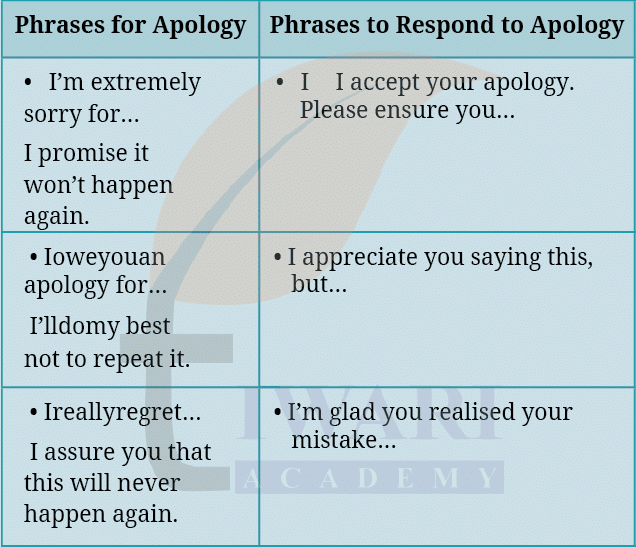
Page 25
Let us write
You are a member of the Nature Club of your school. Draft a notice informing the students of Grades 6-8 about the inauguration of the Herb Garden.
Points to remember:
• Mention the purpose of writing, date, time, venue and any other relevant information—whom to contact, when and where.
• Use formal language in the third person form.
• Write the notice in a box.
Answer:

Page 25
Let us explore
I. Amrit Udyan is a garden spread over an expanse of 15 acres around Rashtrapati Bhavan in New Delhi. It has multiple attractions that include a specially curated garden for children called Bal Vatika, a treehouse, natures classroom, etc. It also has the Bonsai, Herbal-I, Herbal-II, Tactile Garden, Arogya Vanam and Circular Gardens with a diverse variety of flora and fauna.

Now, find out about popular gardens in your region and share with your classmates and teacher.
See AnswerPopular Garden in My Region: Lodhi Garden, Delhi
Lodhi Garden is one of the most well-known gardens in Delhi. It is spread across 90 acres and is home to beautiful lawns, ancient tombs, trees, flowering plants and walking paths. People visit it for morning walks, yoga, picnics, or simply to enjoy nature. It also has historical monuments from the Sayyid and Lodhi dynasties. The peaceful environment and greenery make it a popular spot among locals and tourists.
II. A herbarium is a collection of plant samples preserved for long-term study, usually in the form of dried and pressed plants mounted on paper.

You may follow the link given below for a virtual tour of Amrit Udyan.
https://virtualtour.rashtrapatibhavan.gov.in/
Now, collect some fallen flowers and leaves from your neighbourhood. Place them in folds of a newspaper carefully and put a pile of books on them. After one week, take them out and use them to make a card, wall hanging or any other artwork. A sample has been given for your reference.
Answer:

III. Read and enjoy the poem.
A Sea of Foliage
A sea of foliage girds our garden round,
But not a sea of dull unvaried green,
Sharp contrasts of all colours here are seen;
The light-green graceful tamarinds abound
Amid the mango clumps of green profound,
And palms arise, like pillars gray, between;
And o’er the quiet pools the seemuls lean,
Red—red, and startling like a trumpets sound.
But nothing can be lovelier than the ranges
Of bamboos to the eastward, when the moon
Looks through their gaps, and the white lotus changes
Into a cup of silver. One might swoon
Drunken with beauty then, or gaze and gaze
On a primeval Eden, in amaze.
Toru Dutt
Class 8 English Poorvi Chapter 2 A Concrete Example English to Hindi Translation
English to Hindi Translation: Class 8 English Poorvi Chapter 2
Hindi Translationमेरी पड़ोसन, श्रीमती जोन्स,
के पास पत्थरों से भरा एक बगीचा है:
एक अजीब सा रास्ता, एक कमल का तालाब,
एक चट्टानी उद्यान और उसके पार
एक धूपघड़ी जिसमें एक अजीब सा यंत्र लगा है,
जिसे श्रीमती जोन्स काफी पसंद करती हैं।
My next-door neighbour, Mrs. Jones,
has got a garden full of stones:
A crazy path, a lily pond,
a rockery and, just beyond
A sundial with a strange device,
which Mrs. Jones thinks rather nice.
Hindi Translationमेरी पड़ोसन, श्रीमती जोन्स,
पत्थरों के बीच छोटे-छोटे पौधे लगाती हैं।
वे इतने नाजुक और छोटे हैं,
कि उनका कोई मतलब ही नहीं बनता।
मैं समझ नहीं पाता कि वह उन्हें कैसे लगाती हैं,
शायद पिन की मदद से ही लगाती होंगी।
My next-door neighbour, Mrs. Jones,
puts little plants between the stones
They are so delicate and small,
they don’t mean anything at all.
I can’t think how she gets them in,
unless she plants them with a pin.
Hindi Translationमेरी पड़ोसन, श्रीमती जोन्स,
ने एक दिन मुझे अपने पत्थर दिखाने के लिए बुलाया।
हम एक फूल के बारे में बात करते रहे,
पूरे पंद्रह मिनट तक।
“वह खूबसूरत चीज़ कहाँ है?” मैंने पूछा।
“तुम उस पर खड़े हो”, उन्होंने जवाब दिया।
My next-door neighbour, Mrs. Jones,
once asked me round to see her stones.
We stood and talked about a flower
for quite a quarter of an hour.
“Where is this lovely thing?” I cried.
“You’re standing on it”, she replied.
Summary in English and Hindi of New Edition Chapter 2 A Concrete Example of Class 8 English Poorvi.
Class 8 Poorvi Chapter 2 Summary in English and Hindi
Summary of the poem “My Next-Door Neighbour, Mrs. Jones”
The poem humorously describes the poet’s neighbour, Mrs. Jones, who is fond of decorating her garden with stones. Her garden includes a stone path, a lily pond, a rockery, and a sundial. Between the stones, she plants very tiny, delicate flowers that are almost invisible. The poet finds it amusing how she manages to plant such small things. One day, Mrs. Jones invites the poet to see her garden. As they talk about a flower for a long time, the poet asks where it is—only to find out she has been standing on it! The poem uses gentle humour to portray Mrs. Jones’ unusual love for small things and shows how people find joy in what others might ignore.
Summary in Hindiकविता “मेरी पड़ोसी मिसेज़ जोन्स” का सारांश
यह कविता कवि की पड़ोसी मिसेज़ जोन्स के अनोखे बगीचे के बारे में है। मिसेज़ जोन्स ने अपने बगीचे में पत्थरों से सुंदर सजावट की है—एक पत्थरों का रास्ता, एक लिली वाला तालाब, एक चट्टानों की सजावट और एक सुंदर सूर्यघड़ी। इन पत्थरों के बीच वह बहुत ही नाजुक और छोटे-छोटे पौधे लगाती हैं, जो देखने में इतनी छोटी होती हैं कि किसी का उस पर ध्यान भी नहीं जाता। कवि को हैरानी होती है कि वह इतने नन्हें पौधों को लगाती कैसे हैं—क्या वह उन्हें सुई से लगाती हैं? एक दिन मिसेज़ जोन्स उन्हें बगीचा दिखाने बुलाती हैं और एक फूल के बारे में बातचीत होती है। जब कवि पूछते हैं कि फूल कहाँ है, तो मिसेज़ जोन्स हँसकर कहती हैं—“आप उसी पर खड़े हैं!” यह कविता हल्के-फुल्के अंदाज़ में मिसेज़ जोन्स की बारीकी से प्रकृति प्रेम को दर्शाती है।
What does Chapter 2 A Concrete Example focus on in Class 8 English Poorvi?
Class 8 English New Edition Chapter 2 highlights the power of wit and wisdom through a humorous anecdote. It uses clever storytelling to demonstrate how a simple, logical solution can resolve a complex or seemingly difficult problem. This chapter encourages students to appreciate sharp thinking and creativity in daily life situations.
How do NCERT Solutions help in understanding Chapter 2 of Class 8 English Poorvi Unit 1?
The NCERT Solutions break down the chapter into simple explanations and provide accurate answers to all textbook questions. They guide students through the storyline, enhance their vocabulary and support grammar understanding. This ensures a deeper grasp of the lesson and improves answer-writing skills.
Are Grade 8 English Poorvi solutions aligned with the Session 2025–26 syllabus?
Yes, Class 8 English Poorvi solutions strictly follow the updated curriculum for Session 2025–26. They are crafted to aid both self-study and classroom learning, ensuring students can revise and practice effectively.


